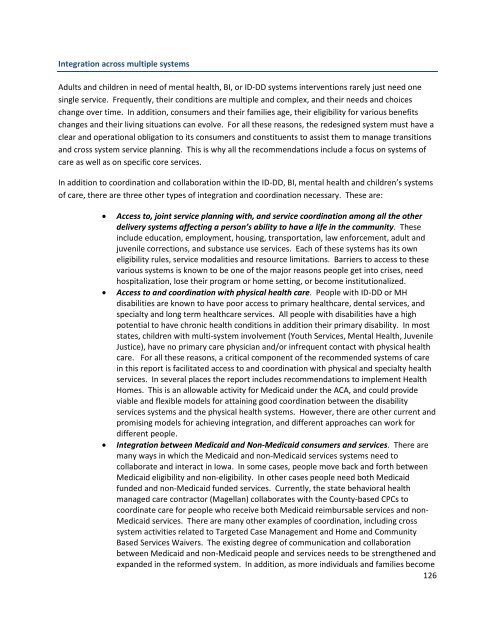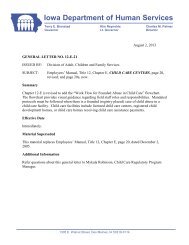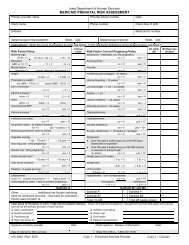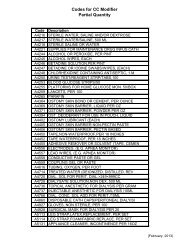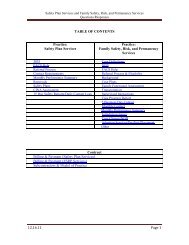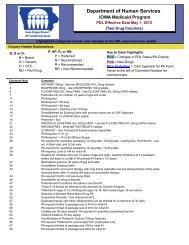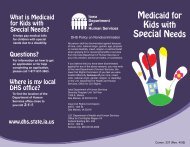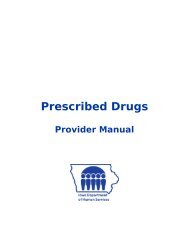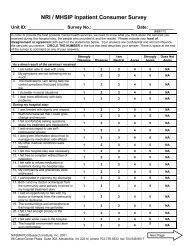Iowa Mental Health and Disability Services System Redesign Interim ...
Iowa Mental Health and Disability Services System Redesign Interim ...
Iowa Mental Health and Disability Services System Redesign Interim ...
- No tags were found...
You also want an ePaper? Increase the reach of your titles
YUMPU automatically turns print PDFs into web optimized ePapers that Google loves.
Integration across multiple systems<br />
Adults <strong>and</strong> children in need of mental health, BI, or ID-DD systems interventions rarely just need one<br />
single service. Frequently, their conditions are multiple <strong>and</strong> complex, <strong>and</strong> their needs <strong>and</strong> choices<br />
change over time. In addition, consumers <strong>and</strong> their families age, their eligibility for various benefits<br />
changes <strong>and</strong> their living situations can evolve. For all these reasons, the redesigned system must have a<br />
clear <strong>and</strong> operational obligation to its consumers <strong>and</strong> constituents to assist them to manage transitions<br />
<strong>and</strong> cross system service planning. This is why all the recommendations include a focus on systems of<br />
care as well as on specific core services.<br />
In addition to coordination <strong>and</strong> collaboration within the ID-DD, BI, mental health <strong>and</strong> children’s systems<br />
of care, there are three other types of integration <strong>and</strong> coordination necessary. These are:<br />
• Access to, joint service planning with, <strong>and</strong> service coordination among all the other<br />
delivery systems affecting a person’s ability to have a life in the community. These<br />
include education, employment, housing, transportation, law enforcement, adult <strong>and</strong><br />
juvenile corrections, <strong>and</strong> substance use services. Each of these systems has its own<br />
eligibility rules, service modalities <strong>and</strong> resource limitations. Barriers to access to these<br />
various systems is known to be one of the major reasons people get into crises, need<br />
hospitalization, lose their program or home setting, or become institutionalized.<br />
• Access to <strong>and</strong> coordination with physical health care. People with ID-DD or MH<br />
disabilities are known to have poor access to primary healthcare, dental services, <strong>and</strong><br />
specialty <strong>and</strong> long term healthcare services. All people with disabilities have a high<br />
potential to have chronic health conditions in addition their primary disability. In most<br />
states, children with multi-system involvement (Youth <strong>Services</strong>, <strong>Mental</strong> <strong>Health</strong>, Juvenile<br />
Justice), have no primary care physician <strong>and</strong>/or infrequent contact with physical health<br />
care. For all these reasons, a critical component of the recommended systems of care<br />
in this report is facilitated access to <strong>and</strong> coordination with physical <strong>and</strong> specialty health<br />
services. In several places the report includes recommendations to implement <strong>Health</strong><br />
Homes. This is an allowable activity for Medicaid under the ACA, <strong>and</strong> could provide<br />
viable <strong>and</strong> flexible models for attaining good coordination between the disability<br />
services systems <strong>and</strong> the physical health systems. However, there are other current <strong>and</strong><br />
promising models for achieving integration, <strong>and</strong> different approaches can work for<br />
different people.<br />
• Integration between Medicaid <strong>and</strong> Non-Medicaid consumers <strong>and</strong> services. There are<br />
many ways in which the Medicaid <strong>and</strong> non-Medicaid services systems need to<br />
collaborate <strong>and</strong> interact in <strong>Iowa</strong>. In some cases, people move back <strong>and</strong> forth between<br />
Medicaid eligibility <strong>and</strong> non-eligibility. In other cases people need both Medicaid<br />
funded <strong>and</strong> non-Medicaid funded services. Currently, the state behavioral health<br />
managed care contractor (Magellan) collaborates with the County-based CPCs to<br />
coordinate care for people who receive both Medicaid reimbursable services <strong>and</strong> non-<br />
Medicaid services. There are many other examples of coordination, including cross<br />
system activities related to Targeted Case Management <strong>and</strong> Home <strong>and</strong> Community<br />
Based <strong>Services</strong> Waivers. The existing degree of communication <strong>and</strong> collaboration<br />
between Medicaid <strong>and</strong> non-Medicaid people <strong>and</strong> services needs to be strengthened <strong>and</strong><br />
exp<strong>and</strong>ed in the reformed system. In addition, as more individuals <strong>and</strong> families become<br />
126


